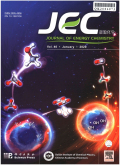- 钛学术文献服务平台 \
- 学术期刊 \
- 工业技术期刊 \
- 石油与天然气工业期刊 \
- 能源化学期刊 \
Improving the performance of perovskite solar cells by surface passivation
Improving the performance of perovskite solar cells by surface passivation
基本信息来源于合作网站,原文需代理用户跳转至来源网站获取
摘要:
NiO has a perfect-aligned energy level with CH3NH3PbI3 perovskite such that it serves as a hole transport layer (HTL), but NiO-based perovskite solar cells (PSCs) still suffer from low efficiency due to the poor in-terface contact between the perovskite layer and the NiO HTL, and haphazardly stacked perovskite grains. Herein, poly[(9,9-dioctylfluorenyl-2,7-diyl)-alt-co-(1,4-benzo-{2,1',3}-thiadiazole)] (PFBT) is introduced be-tween the NiO and perovskite layers in the form of a polymer aggregate to enhance perovskite crys-tallinity and decrease the interface charge recombination between perovskite and NiO in PSCs, resulting in an improved performance. Moreover, PFBT modified perovskite films showed sharper, smoother, and more compact crystalline grains with fewer grain boundaries, leading to the decreased nonradiative re-combination. This study offers a simple strategy to achieve highly efficient PSCs with the incorporation of polymer semiconductor aggregates to passivate the interface between the perovskite and NiO layers.

推荐文章
Snowball Earth at low solar luminosity prevented by the ocean–atmosphere coupling
Faint Young Sun paradox
Carbon dioxide
Earth system
Siderite
Geochemical tracing and modeling of surface and deep water-rock interactions in elementary granitic
Weathering
Water pathways
U activity ratios
Sr isotope ratios
Anthropogenic gases (CFC,SF6)
CZO
杂质SO42-对Solar Salt熔盐热物性的影响及分析
Solar Salt熔盐
热物性
杂质离子
混合熔盐
内容分析
关键词云
关键词热度
相关文献总数
(/次)
(/年)
引文网络
引文网络
二级参考文献 (0)
共引文献 (0)
参考文献 (0)
节点文献
引证文献 (0)
同被引文献 (0)
二级引证文献 (0)
2020(0)
- 参考文献(0)
- 二级参考文献(0)
- 引证文献(0)
- 二级引证文献(0)
引文网络交叉学科
相关学者/机构
期刊影响力
能源化学
主办单位:
中国科学院大连化学物理研究所
中国科学院成都有机化学研究所
出版周期:
双月刊
ISSN:
2095-4956
CN:
10-1287/O6
开本:
出版地:
大连市中山路457号
邮发代号:
创刊时间:
语种:
eng
出版文献量(篇)
2804
总下载数(次)
0
总被引数(次)
7996
期刊文献
相关文献
推荐文献
- 期刊分类
- 期刊(年)
- 期刊(期)
- 期刊推荐
一般工业技术
交通运输
军事科技
冶金工业
动力工程
化学工业
原子能技术
大学学报
建筑科学
无线电电子学与电信技术
机械与仪表工业
水利工程
环境科学与安全科学
电工技术
石油与天然气工业
矿业工程
自动化技术与计算机技术
航空航天
轻工业与手工业
金属学与金属工艺
能源化学2022
能源化学2021
能源化学2020
能源化学2019
能源化学2018
能源化学2017
能源化学2016
能源化学2015
能源化学2014
能源化学2013
能源化学2012
能源化学2011
能源化学2010
能源化学2009
能源化学2008
能源化学2007
能源化学2006
能源化学2005
能源化学2004
能源化学2003
能源化学2002
能源化学2001
能源化学2020年第9期
能源化学2020年第8期
能源化学2020年第7期
能源化学2020年第6期
能源化学2020年第5期
能源化学2020年第4期
能源化学2020年第3期
能源化学2020年第12期
能源化学2020年第11期
能源化学2020年第10期
能源化学2020年第1期

 免费查重
免费查重










